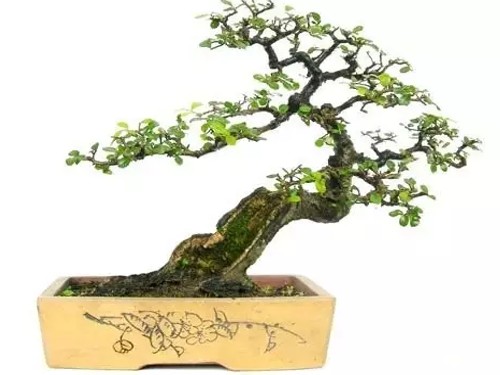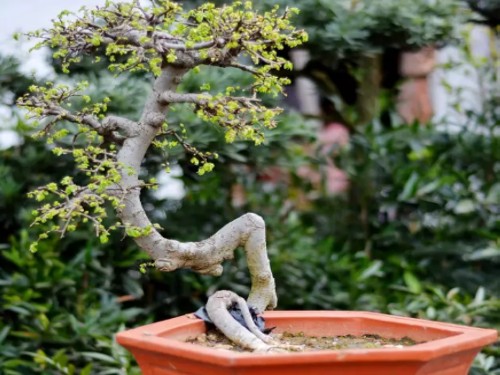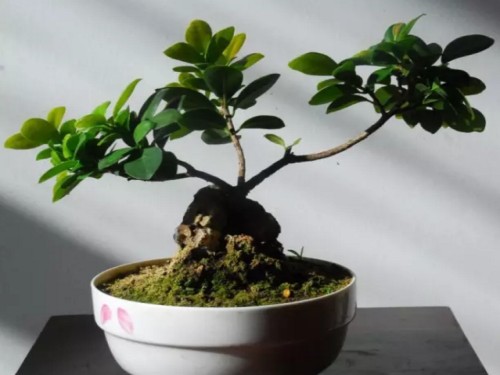What if the leaves of elm bonsai turn yellow?
Elm trees, especially the old piles that grow in the wild, have gradually formed many different strange gestures after years of man-made chopping axe chisels, or wind and rain erosion, animal bites and so on. Some are intertwined, vigorous and simple, while others turn decay into magic, withered roots and new leaves, unique caves, and are excellent materials for making bonsai. Its beautiful tree shape, chic posture, mottled bark, fine branches and leaves, has a high ornamental value. It is suitable to plant alone, in clusters or with pavilions in the garden, and it has a good ornamental effect as shade trees, street trees or bonsai.
To maintain the elm bonsai, it should be placed in a sunny and well-ventilated environment. However, many people responded to the author that their elm bonsai often had yellow leaves and fallen leaves, but they did not know what the problem was. This paper introduces the reasons for the yellowing of elm bonsai leaves.

The reason why the leaves of elm bonsai turn yellow:
1. The temperature is too low, resulting in physiological yellow leaves
2, the water quality is too alkaline, in general, this situation is very rare, just add a little vinegar.
3, too little light, the reason is very simple, photosynthesis.
4. normal alternation of new and old leaves.
5. root rot caused by long-term watering or too much rain and poor drainage at the bottom of the basin. It is recommended that the soil should be loosened immediately, and the basin soil should be watered after drying, and the root should not be fertilized for a short time.
6. No change of soil or application of organic fertilizer for many years, which is caused by the lack of trace elements. It is recommended to replace part of the soil or irrigate micro-fertilizer.
7. Caused by rotten roots. If all the root rot should be hopeless, if there are still a small part of the root is not rotten, it should still be saved, it can be planted in the ground for a period of time and then put on the pot, but we should pay attention to protection and less watering in winter.
There are several other reasons why the leaves turn yellow:
Insufficient sun exposure and excessive watering result in retting roots, rotting roots and STDs caused by foliar bacteria. My friend, this tree looks like retting or rotting roots caused by insufficient sun exposure or too much watering.
Identification of phyllobacteria and venereal diseases
There are two common types: yellow leaf disease, the whole leaf has light green to light yellow and then fall off; spot leaf disease: there are brown spots on the leaf surface, which will fall off after a long period of time. Please refer to the cause in order to prescribe the right medicine to the case.
Attention to maintenance:
1. Adequate light is needed.
Elm trees like light and can grow well only where there is plenty of sunshine. If the light is insufficient, its growth is slow, the branches are thin, the leaf spacing is long, the leaf color is light, and the whisker roots are few and thin. Summer is the golden period of elm rooting, enhanced light will promote its vigorous life activities, accelerate photosynthesis and metabolism, and make the pile roots more developed and stout. And the general family flower cultivation site, there will not be sunshine from morning till night, no shade. Even where the roof platform is illuminated for a long time, as long as the water supply is timely in summer, it is impossible to harm the elm bonsai. The root growth of elm bonsai depends entirely on the adequacy of light.
2. Prevention of stagnant water
Elm trees are most afraid of the soil being too wet. Summer is no exception, a little dry does no harm, too wet harm. Elm trees are more tolerant to drought than to moisture. Many elm bonsai (especially new piles) die in summer, most of them are caused by too much watering. Too much water, high temperature or improper concentration of fertilizer will cause the root system to rot slowly until the end, resulting in the death of elm bonsai in summer.
3. No heavy pruning
In addition to relying on water volatilization to dissipate heat, the regulation function of plant leaf evaporation is very important. Therefore, we must not take large-scale pruning of elm branches and leaves in summer, so as not to destroy its normal regulation function, resulting in non-volatilization of water in basin soil and root system asphyxiation and rot. The light ones are difficult to return to normal growth for a while, while the heavy ones will die soon.
Time: 2019-06-01 Click:
- Prev

What if the elm leaves fall off?
The elm bonsai I bought a month ago was fine at first. After two days of cultivation, aphids began to grow and the leaves withered. Then I wrote on the Internet to remove all the leaves, and spray pepper water, and then improved, began to shoot new buds. But now somehow the leaves start falling again, no bugs this time.
- Next

Causes and treatment of fallen leaves of banyan bonsai
The banyan bonsai refers to the banyan potted plant which is molded by various means with the banyan tree as the material and for the purpose of ornamental. The banyan tree is very vigorous and easy to maintain and manage, but sometimes it also encounters some problems, such as falling leaves and so on. Now many friends like to raise banyan bonsai.
Related
- Fuxing push coffee new agricultural production and marketing class: lack of small-scale processing plants
- Jujube rice field leisure farm deep ploughing Yilan for five years to create a space for organic food and play
- Nongyu Farm-A trial of organic papaya for brave women with advanced technology
- Four points for attention in the prevention and control of diseases and insect pests of edible fungi
- How to add nutrient solution to Edible Fungi
- Is there any good way to control edible fungus mites?
- Open Inoculation Technology of Edible Fungi
- Is there any clever way to use fertilizer for edible fungus in winter?
- What agents are used to kill the pathogens of edible fungi in the mushroom shed?
- Rapid drying of Edible Fungi

